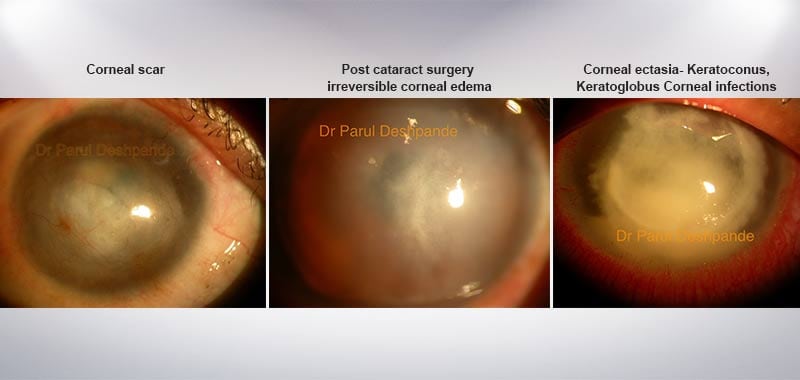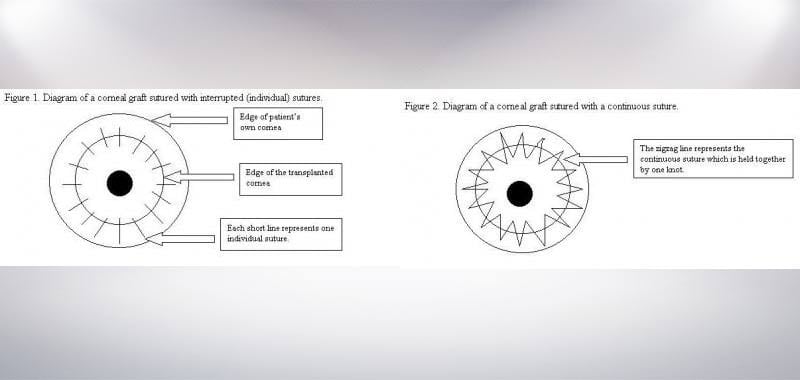

27 Sep Corneal Transplant
Who can undergo corneal transplants?
Any opaque cornea or extreme change in shape of cornea due to following reasons could require a corneal transplant
Why a cornea turns opaque or changes its shape?
Cornea being transparent, any injury or infection can turn it opaque. A condition like keratoconus or any thinning of cornea causes bending of cornea leading to shape change, hence affecting the power of cornea. So anything in cornea that prevents light to enter the inside of eye or changes its power will affect the vision in those eyes.


Are there any contraindications or persons who cannot undergo corneal transplants?
Any patient with systemic medical conditions like DM, HT or heart problem can undergo corneal transplants.
Conditions like uncontrolled Rheumatoid Arthritis with a generalized affection of many parts of the body (like heart) or eyes with Chemical injury or Stevens Johnson syndrome may require additional procedure like limbal transplant or control of the disease before undergoing corneal transplants.
Age is no bar to undergoing corneal transplant.
How is a Corneal Transplant procedure done?
It is mostly performed under local anesthesia; rarely requiring general anesthesia esp. in children.
In a conventional full thickness corneal transplant, the affected central few millimeters of cornea is cut out with special instrument called corneal trephine (which is disposable). A similarly sized cut is made in the donor cornea with the trephine and oriented well before anchoring to the recipient eye by multiple stitches. This procedure may be combined with other procedures like cataract removal or intraocular lens implantation or exchange etc.
In the recent past, introduction of lamellar corneal transplant procedures have changed the process to either a suture less or even a relatively rejection free corneal graft in man cases.


Types of corneal Transplant surgeries
1.Full Thickness Keratoplasty-where all the layers of cornea are replaced with the donor cornea.
2.Lamellar corneal transplant-Here only affected diseased layers are replaced with healthy donor layers.this decreases the rejection chances and also in some makes it stitches.
A.DALK
B.DASEK/DSEK
C.DMEK
For details refer to DALK, DSAEK, DMEK.
What is the postoperative care after a corneal transplant?
- No head bath for 15-30 days depending which procedure has been done.
- No rubbing of eyes for a month till good healing is achieved.
- Never splash water into the eyes.
- Avoid weight lifting for a month till wound is secure enough.
- Use drops regularly at a frequency advised.
- Any exposure to daylight is okay immediately after the procedure, if tolerated well. No dark room restrictions. Dark glasses may be worn to improve the light tolerance.
What is the regime of medicines or doctor’s follow up?
A corneal transplant patient has to be under the care of the doctor for lifelong. The frequency of follow up goes down with time. Initially, it is more frequent at weekly, monthly or bimonthly interval in first year of transplant, later becoming half yearly the next year and then yearly, if no problems. More frequent follow ups may be required in high risk cases which are more prone to rejections, like multiple corneal transplants or
associated glaucoma etc.
A regular check up of eye pressures is essential at all visits.
Medicines in the form of drops, need to be continued usually for 1-2 years depending upon the risk factors for rejection.
What is the vision like after corneal transplant?
One can see well after the transplant, if everything is okay in the inside of eye. The level of vision will also depend upon the shape of cornea due to multiple stitches. Removing stitches selectively after three months of the operation can reduce large spectacle power after corneal transplant. This process is slow and hence a complete visual recovery may be delayed up to a year. The vision can be normalized in high glass powers with glasses or specialized contact lenses in most cases.
Any failure to see well can be explained to you by your doctor.
Some facts you need to know
- No matching the cornea is done with the diseased eye or blood.
- Race, gender or the eye color of the donor is not important.
- A corneal transplant will not change your natural colour of the eye.
- Healing of the graft is slow and hence vision recovery is also slow and may take up to a year.
- It is difficult to shape the new cornea perfectly, so astigmatism may be common after transplant. It can however be corrected as discussed earlier.
- Visual rehabilitation may need repeated selective suture removal. This is an outpatient procedure and does not involve any pain.
- Any unusual redness, pain, watering, irritation or decrease of vision: Inform/Consult your doctor immediately.
What is corneal rejection or failure?
A cornea can fail because of many reasons like rejection (immune mediated) or infections. Any failure to see properly may not be always the corneal failure but may be due to problems with retina or other parts of the eye. It may not be possible to detect the exact visual recovery before the operation many times as it is not possible to visualize the inside of the eye due to opaque cornea but your doctor can tell you the chance of getting better vision based on some eye tests many times.
A corneal rejection is an immune mediated attack of body defense system, recognizing donated cornea as non-self. It is usually sudden onset and is mostly preventable. Any rejection, if occurs, if detected and treated within minutes to hours of onset, can be reversed with treatment with medicines and one can prevent corneal graft failure due to rejection.
There are following signs of rejection which one should always keep in mind for lifelong
- Any sudden increase in redness, pain or drop of vision or shadows in part of vision may indicate early rejection.
- Any sign of loose or broken stitch like irritation or foreign body sensation should not be ignored, as it is one of the common causes of inducing rejection.
One should immediately contact the doctor when these symptoms appear.


Sorry, the comment form is closed at this time.